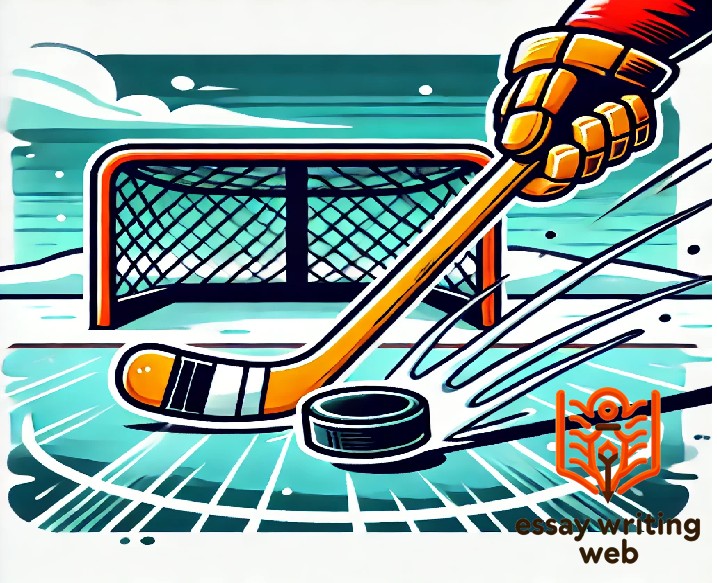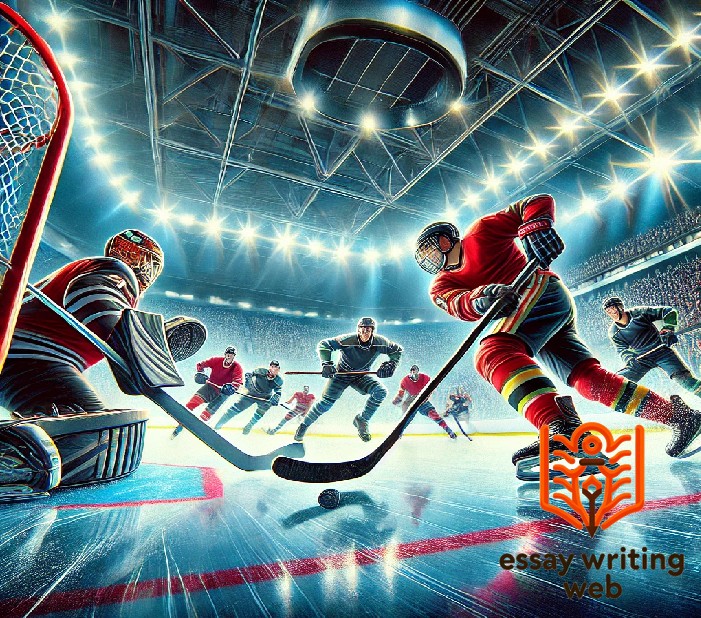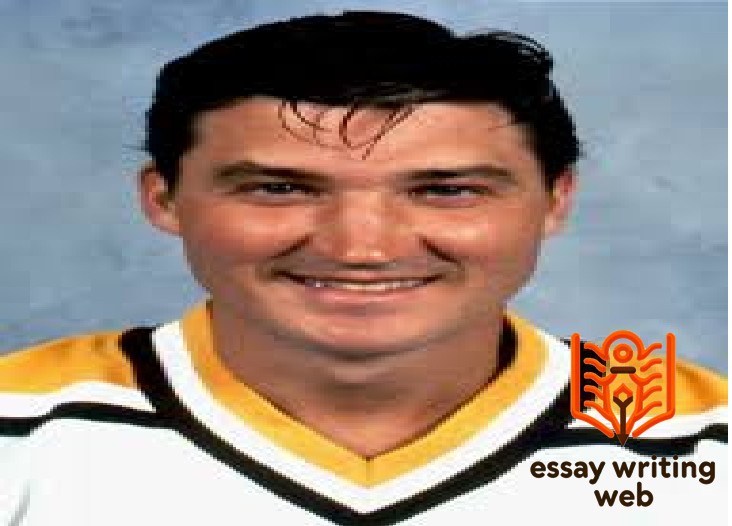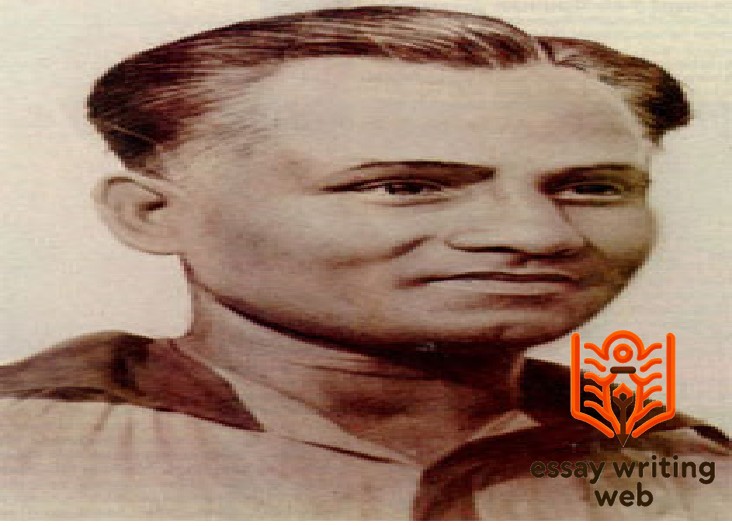 Essay Writing Web
Essay Writing Web

 29-08-2024
29-08-2024
 www.essaywritingweb.com
www.essaywritingweb.com
Hockey, a dynamic and exhilarating sport, stands out as a testament to human ingenuity and athleticism. Known for its high-paced action, strategic play, and physical demands, hockey has captivated athletes and fans around the world. Its diverse forms, including ice hockey, field hockey, roller hockey, and indoor hockey, each offer unique characteristics and appeal, making the sport accessible to a wide audience.
At its core, hockey involves two teams competing to score goals by maneuvering a ball or puck into the opposing team's net using sticks. This simple premise belies the complexity and depth of the game, which combines elements of speed, skill, and strategy. Whether played on ice, grass, or other surfaces, hockey demands a high level of coordination, teamwork, and physical endurance from its players.
Ice hockey, perhaps the most widely recognized form of the sport, is played on a sheet of ice with skates and a puck. Originating in Canada in the late 19th century, it quickly gained popularity and evolved into a major international sport with professional leagues such as the National Hockey League (NHL) in North America and various European leagues. The sport's appeal is enhanced by its fast-paced nature, physical contact, and the skillful maneuvers of players on ice.
Field hockey, on the other hand, is played on a grass or artificial turf field and involves a hard ball. It has a long history dating back to ancient civilizations and has been particularly popular in countries like India, the Netherlands, and Australia. The game emphasizes skillful dribbling, strategic passing, and precise shooting, reflecting the sport's rich tradition and evolving techniques.
Roller hockey and indoor hockey offer variations that adapt the traditional game different environments. Roller hockey, played on wheels, combines elements of both ice hockey and field hockey, while indoor hockey is a variant designed for play in enclosed arenas, often featuring a smaller field and different rules.
The global appeal of hockey is evident in its widespread presence across continents, with international tournaments such as the Hockey World Cup and the Olympic Games showcasing the sport's talent and diversity. Hockey's ability to bring together players and fans from various backgrounds highlights its universal appeal and the shared passion for the game.
Hockey is a diverse and thrilling sport that comes in several distinct forms, each with its own set of rules, playing surfaces, and cultural significance. While all types of hockey share a common objective—scoring goals by maneuvering a puck or ball into the opponent's net—each variant offers a unique experience for players and fans alike. The primary types of hockey include ice hockey, field hockey, roller hockey, and indoor hockey, each with its own history and characteristics.
Ice hockey is arguably the most widely recognized form of the sport. Played on a rink covered in ice, the game is characterized by its fast pace, physicality, and skillful skating. Players wear skates, helmets, and padded gear to protect against the high-speed collisions and intense play. The objective is to score goals by shooting a small rubber puck into the opponent's net. Ice hockey's roots trace back to Canada in the late 19th century, and it has since grown into a global phenomenon with professional leagues such as the National Hockey League (NHL) and prominent international tournaments, including the Winter World Championships and Olympics.

Field hockey, distinguished by its play on grass or artificial turf, presents a different set of challenges and techniques compared to ice hockey. Played with a hard ball and curved sticks, field hockey emphasizes agility, dribbling, and strategic passing. The game involves two teams of eleven players each and goals are scored by hitting the ball into a net guarded by a goalkeeper. Field hockey has a long history, with origins tracing back to ancient civilizations. It became codified in the late 19th century in England, and today it is especially popular in countries like India, the Netherlands, and Australia. Field hockey's blend of skillful play and strategic depth makes it a captivating sport on the global stage.

Roller hockey is a variant of the sport played on a hard surface using roller skates. There are two main types: quad roller hockey and inline roller hockey. Quad roller hockey, played with traditional four-wheeled skates, is similar in rules and style to ice hockey but adapted for a non-ice surface. Inline roller hockey, using skates with wheels arranged in a single line, incorporates elements of both ice hockey and field hockey, often with its own set of rules and playing style. Roller hockey is popular in various regions, including parts of Europe and North America, and provides a unique adaptation of hockey for different environments.

Indoor hockey is played in enclosed arenas or gymnasiums on a smaller, hard surface. The game is typically played with a ball rather than a puck and involves a smaller number of players, usually six per side. Indoor hockey shares some similarities with field hockey but is adapted for a confined space, which influences the pace and strategy of play. It is commonly played in Europe and has specific rules to accommodate the indoor setting, such as restrictions on the use of the boards and walls.

Hockey, a sport renowned for its exhilarating pace and strategic depth, has evolved significantly from its ancient origins to its contemporary forms. The sport's development, from rudimentary stick-and-ball games to highly organized modern versions, reflects its global appeal and adaptability. Understanding the origins and evolution of hockey, as well as its rules and regulations, provides insight into how this beloved sport has become a central part of athletic culture around the world.
The roots of hockey can be traced back to ancient civilizations, where early forms of stick-and-ball games were played. Evidence suggests that similar games were enjoyed by ancient Egyptians, Greeks, and Romans, who used sticks to strike balls in various competitive contexts. However, the specific lineage of modern hockey can be more clearly traced to medieval Europe.
In medieval England, a game known as "hockey on the ground" was popular, played with a wooden stick a ball on fields or open spaces. This early form of hockey resembled modern field hockey and was an integral part of local communities. In the 17th and 18th centuries, these early games began to be formalized, with the establishment of standardized rules and organized competitions.
The formalization of hockey began in the late 19th century. In 1886, the Hockey Association was founded in England, marking a significant step in the sport's evolution by codifying rules and organizing competitions. This was a pivotal moment for field hockey, establishing a structured format that would influence the development of the sport globally. The International Hockey Federation (FIH) was founded in 1924, further internationalizing the sport and leading to the establishment of global tournaments such as the Hockey World Cup and the Olympic Games.
Ice hockey, a distinct but related sport, began to take shape in Canada in the late 19th century. Evolving from various stick-and-puck games played on ice, such as "shinny," ice hockey was first formally organized in Montreal in 1875. The establishment of the National Hockey League (NHL) in 1917 marked a crucial development, propelling the sport into the international spotlight. Ice hockey's growth was characterized by the introduction of professional leagues, major tournaments, and innovations in equipment and play.
The rules and regulations of hockey have evolved to ensure fair play, safety, and competitive balance across its various forms. While each type of hockey—ice, field, roller, and indoor—has its own specific set of rules, some fundamental principles are shared.
Hockey's inclusion in the Olympic Games marks a significant milestone in its history, highlighting the sport's global appeal and competitive spirit. Since its debut, Olympic hockey has evolved to become one of the premier stages for showcasing the world's best talent in both ice and field hockey. The journey of hockey in the Olympics is a story of growth, challenges, and extraordinary achievements that have helped shape the sport as we know it today.
Ice hockey made its Olympic debut at the 1920 Summer Olympics in Antwerp, Belgium, as a demonstration sport. The event was a significant moment for the sport, which had already gained considerable popularity in Canada and the United States. However, it was not until the 1924 Winter Olympics in Chamonix, France, that ice hockey was officially included as a medal event. This marked the beginning of ice hockey's presence in the Winter Games, where it has since become a central feature.
The inclusion of ice hockey in the Winter Olympics was a pivotal moment, as it provided a global platform for the sport and helped to standardize its rules and regulations. Over the years, the Winter Olympics have become synonymous with ice hockey, showcasing the sport's most talented players and most intense competitions. The National Hockey League (NHL) players' participation, starting in 1998, further elevated the level of competition and international interest. The inclusion of professionals has led to memorable tournaments, such as the dramatic gold medal games and the emergence of new hockey powerhouses.
Field hockey's journey to the Olympic stage began earlier than ice hockey, making its debut at the 1908 London Games. Initially, field hockey was contested by only three teams: England, Ireland, and Scotland. The sport's early Olympic appearances were sporadic, with field hockey being omitted from the 1912 Stockholm Games and later from the 1932 Los Angeles Games. However, field hockey was reintroduced and has been a regular feature in the Olympics since the 1948 London Games.
Field hockey's Olympic history is marked by notable achievements and the development of strong international rivalries. The Indian team, in particular, dominated the early years of Olympic field hockey, winning six consecutive gold medals from 1928 to 1956. This era cemented India's status as a powerhouse in the sport. Over the decades, other countries such as the Netherlands, Australia, and Germany have emerged as strong competitors, contributing to the sport's growing global appeal.
Hockey, a sport known for its speed, skill, and physicality, has been graced by numerous legendary players whose contributions have shaped the game's history. From the icy rinks of the NHL to the fields of international tournaments, these players have not only excelled in their sport but have also inspired countless fans and future athletes. This essay explores some of the most famous hockey players across various forms of the sport, highlighting their achievements and enduring impact.
Often hailed as "The Great One," Wayne Gretzky is widely regarded as greatest ice hockey player of all time. Born in Brantford, Ontario, Canada, in 1961, Gretzky's career in the NHL spanned from 1979 to 1999. His exceptional vision, passing ability, and scoring prowess set numerous records, including the most career points, goals, and assists. Gretzky's influence extended beyond his on-ice performance; he elevated the popularity of hockey in the United States and contributed to the growth of the sport globally. His legacy includes four Stanley Cups with the Edmonton Oilers and an induction into the Hockey Hall of Fame in 1999.

Mario Lemieux, a contemporary of Wayne Gretzky, is another iconic figure in the world of ice hockey. Born in Montreal, Quebec, in 1965, Lemieux's career was marked by his remarkable skill and athleticism. Playing primarily for the Pittsburgh Penguins, Lemieux was known for his dominant offensive play and resilience. Despite battling significant health issues, including back problems and cancer, he achieved tremendous success, including two Stanley Cups and multiple MVP awards. Lemieux's impact on the game was profound, and he remains a revered figure in hockey history, not only for his playing career but also for his contributions as an owner and executive.

In the realm of field hockey, Dhyan Chand stands out as one of the sport's most legendary. Born in Allahabad, India, in 1905, Chand's career is synonymous with Indian hockey's golden era. His exceptional skill and goal-scoring ability earned him the nickname "The Wizard of Hockey." Chand led the Indian national team to three Olympic gold medals (1928, 1932, and 1936) and was renowned for his dazzling dribbling and innovative techniques. His influence extended beyond his playing career, as he became an enduring symbol of Indian hockey and inspired future generations of players.

Paula Infante, a prominent figure in women's field hockey, represents a modern era of excellence in the sport. Born in Santiago, Chile, in 1983, Infante's career has been marked by her exceptional skills and leadership. As a key player for the Chilean national team, she has achieved significant success on the international stage, including competing in the World Cup and the Pan American Games. Infante's contributions have been pivotal in raising the profile of women's field hockey in Chile and around the world, and she is celebrated for her dedication to the sport and her role as an ambassador for women's athletics.

Jaromír Jágr, a Czech ice hockey star, has had a remarkable career that spans over four decades. Born in Kladno, Czech Republic, in 1972, Jágr is known for his powerful skating, offensive skills, and longevity in the sport. Over his extensive career, Jágr played for several NHL teams, including the Pittsburgh Penguins and the Florida Panthers. His achievements include winning two Stanley Cups and accumulating over 1,900 career points, placing him among the top scorers in NHL history. Jágr's dedication to the game and his ability to compete at a high level well into his 40s have solidified his place as one of hockey's greats.

Dhyan Chand, born in Allahabad, India, in 1905, is celebrated as one of the greatest field hockey players of all time. His career, which spanned from the late 1920s to the early 1940s, is marked by unparalleled skill and extraordinary accomplishments. Chand's nickname, "The Wizard of Hockey," reflects his magical ability to control the ball and execute stunning plays, a talent that captivated audiences and opponents alike.
Chand's most significant contributions to field hockey came during his time with the Indian national team. Under his leadership India won three consecutive Olympic gold medals in 1928, 1932, and 1936. These victories were pivotal in establishing India's dominance in the sport and elevating field hockey's profile on the global stage. Chand's performance in these tournaments was nothing short of legendary, with his deft dribbling, precise passing, and goal-scoring prowess playing a crucial role in India's success.
In addition to his Olympic achievements, Chand's influence extended beyond his playing career. He was instrumental in popularizing field hockey in India and inspiring future generations of players. His contributions to the sport were recognized globally, and he remains a revered figure in field hockey history.
Rachael Lynch, born in Perth, Australia, in 1984, represents a modern era of excellence in field hockey. As a prominent goalkeeper for the Australian national team, Lynch has made significant contributions to the sport through her exceptional skills and leadership on the field.
Lynch's career is distinguished by her outstanding performances in major international tournaments. She has been a key player for the Hockeyroos, Australia's national women's field hockey team, contributing to their success in various competitions. Lynch's agility, reflexes, and strategic play have made her one of the top goalkeepers in the world.
One of Lynch's most notable achievements came at the 2018 Women's Hockey World Cup, where her remarkable goalkeeping played a crucial role in helping Australia secure a bronze medal. Her contributions were pivotal in Australia’s strong performances in other major tournaments, including the Commonwealth Games and the FIH Pro League.
Beyond her on-field achievements, Lynch has been an influential advocate for women's field hockey. Her dedication to the sport and her role as a mentor for younger players has helped to elevate the profile of women's hockey in Australia and internationally. Lynch's commitment to excellence and her impact on the sport reflect her status as a trailblazer in modern field hockey.